Interactions of Cd2+, Co2+ and MoO42− Ions with Crushed Concrete Fines
Abstract
1. Introduction
2. Materials and Methods
2.1. Preparation of Crushed Concrete Fines (CCF)
2.2. Sorption of Cd2+, Co2+ and MoO42− by CCF
2.3. Equilibrium Removal of Cd2+, Co2+ and MoO42− by CCF
2.4. Isotherm Models
2.5. Binding and Leaching of Cd2+, Co2+ and MoO42− from Metal-Laden CCF
2.6. Characterisation of Metal-Laden CCF by SEM
3. Results
3.1. Characterisation of CCF
3.2. Kinetics of Removal of Cd2+, Co2+ and MoO42− by CCF
3.3. Isotherm Models of Equilibrium Removal of Cd2+, Co2+ and MoO42− by CCF
3.4. The Fate of the Cd2+, Co2+ and MoO42− Species Bound to CCF
3.5. Leaching of Cd2+, Co2+ and MoO42− Species Bound to CCF
4. Discussion
5. Conclusions
Author Contributions
Funding
Acknowledgments
Conflicts of Interest
References
- Jelić, I.V.; Sljivic-Ivanovic, M.; Dimović, S.D.; Antonijević, D.L.; Jovic, M.; Vujović, Z.; Smiciklas, I. Radionuclide Immobilization by Sorption onto Waste Concrete and Bricks—Experimental Design Methodology. Water Air Soil Pollut. 2019, 230, 242. [Google Scholar] [CrossRef]
- Zimbili, O.; Salim, W.; Ndambuki, M. A review on the usage of ceramic wastes in concrete production. Int. J. Civ. Archit. Struct. Constr. Eng. 2014, 8, 91–95. [Google Scholar]
- Chen, Q.; Lan, Q.; Li, X.; Zhou, J.; Yang, Z.; Zhou, Y. Utilization of fine powder in demolition concrete as recyclable coagulant in removing color from dye-bearing wastewater. Environ. Earth Sci. 2015, 74, 6737–6745. [Google Scholar] [CrossRef]
- Kucukvar, M.; Eğilmez, G.; Tatari, O. Evaluating environmental impacts of alternative construction waste management approaches using supply-chain-linked life-cycle analysis. Waste Manag. Res. 2014, 32, 500–508. [Google Scholar] [CrossRef]
- Sljivic-Ivanovic, M.; Jelić, I.V.; Dimovic, S.; Antonijević, D.L.; Jovic, M.; Mraković, A.; Smiciklas, I. Exploring innovative solutions for aged concrete utilization: Treatment of liquid radioactive waste. Clean Technol. Environ. Policy 2018, 20, 1343–1354. [Google Scholar] [CrossRef]
- Jelić, I.; Šljivić-Ivanović, M.; Dimović, S.; Antonijević, D.; Jović, M.; Mirković, M.; Smičiklas, I. The applicability of construction and demolition waste components for radionuclide sorption. J. Clean. Prod. 2018, 171, 322–332. [Google Scholar] [CrossRef]
- Grace, M.A.; Clifford, E.; Healy, M.G. The potential for the use of waste products from a variety of sectors in water treatment processes. J. Clean. Prod. 2016, 137, 788–802. [Google Scholar] [CrossRef]
- EU Construction and Demolition Waste Protocol and Guidelines. Available online: https://ec.europa.eu/growth/content/eu-construction-and-demolition-waste-protocol-0_en (accessed on 10 January 2020).
- EPA Sustainable Management of Construction and Demolition Materials. Available online: https://www.epa.gov/smm/sustainable-management-construction-and-demolition-materials. (accessed on 29 December 2020).
- Coleman, N.J.; Lee, W.E.; Slipper, I.J. Interactions of aqueous Cu, Zn and Pb ions with crushed concrete fines. J. Hazard. Mater. 2005, 121, 203–213. [Google Scholar] [CrossRef]
- Kumara, G. Reviews on the applicability of construction and demolition waste as low-cost adsorbents to remove-heavy metals in wastewater. Int. J. 2018, 14, 44–51. [Google Scholar] [CrossRef]
- Shin, W.-S.; Kim, Y.-K. Removal Characteristics of Heavy Metals from Aqueous Solution by Recycled Aggregate and Recycled Aggregate/Steel Slag Composites as Industrial Byproducts. Appl. Chem. Eng. 2015, 26, 477–482. [Google Scholar] [CrossRef][Green Version]
- Shin, W.-S.; Na, K.-R.; Kim, Y.-K. Adsorption of metal ions from aqueous solution by recycled aggregate: Estimation of pretreatment effect. Desalin. Water Treat. 2015, 57, 9366–9374. [Google Scholar] [CrossRef]
- Damrongsiri, S. Feasibility of using demolition waste as an alternative heavy metal immobilising agent. J. Environ. Manag. 2017, 192, 197–202. [Google Scholar] [CrossRef] [PubMed]
- Kumara, G.M.P.; Kawamoto, K.; Saito, T.; Hamamoto, S.; Asamoto, S. Evaluation of Autoclaved Aerated Concrete Fines for Removal of Cd(II) and Pb(II) from Wastewater. J. Environ. Eng. 2019, 145, 04019078. [Google Scholar] [CrossRef]
- Ali, A.F.; Ali, Z.T.A. Removal of lead ions from wastewater using crushed concrete demolition waste. Assoc. Arab. Univ. J. Eng. Sci. 2019, 26, 22–29. [Google Scholar] [CrossRef]
- Ali, A.F.; Ali, Z.T.A. Interaction of Aqueous Cu2+ Ions with Granules of Crushed Concrete. Iraqi J. Chem. Pet. Eng. 2019, 20, 31–38. [Google Scholar] [CrossRef]
- Yoo, J.; Shin, H.; Ji, S. Evaluation of the Applicability of Concrete Sludge for the Removal of Cu, Pb, and Zn from Contaminated Aqueous Solutions. Metals 2018, 8, 666. [Google Scholar] [CrossRef]
- Kittnerová, J.; Drtinová, B.; Štamberg, K.; Vopálka, D.; Evans, N.; Deissmann, G.; Lange, S. Comparative study of radium and strontium behaviour in contact with cementitious materials. Appl. Geochem. 2020, 122, 104713. [Google Scholar] [CrossRef]
- Liu, C.; Yang, Y.; Wan, N. Kinetic studies of phosphate adsorption onto construction solid waste (CSW). Water Qual. Res. J. 2014, 49, 307–318. [Google Scholar] [CrossRef]
- Egemose, S.; Sønderup, M.J.; Beinthin, M.V.; Reitzel, K.; Hoffmann, C.C.; Flindt, M.R. Crushed Concrete as a Phosphate Binding Material: A Potential New Management Tool. J. Environ. Qual. 2012, 41, 647–653. [Google Scholar] [CrossRef]
- Wu, L.; Tang, J.; Zhang, S.; Wang, J.; Ding, X. Using Recycled Concrete as an Adsorbent to Remove Phosphate from Polluted Water. J. Environ. Qual. 2019, 48, 1489–1497. [Google Scholar] [CrossRef]
- Dos Reis, G.S.; Cazacliu, B.G.; Correa, C.R.; Ovsyannikova, E.; Kruse, A.; Sampaio, C.H.; Lima, E.C.; Dotto, G.L. Adsorption and recovery of phosphate from aqueous solution by the construction and demolition wastes sludge and its potential use as phosphate-based fertiliser. J. Environ. Chem. Eng. 2020, 8, 103605. [Google Scholar] [CrossRef]
- Kim, Y.-K.; Shin, W.-S. Effects of Capping with Recycled Aggregates and Natural Zeolite on Inhibition of Contaminants Release from Marine Sediment. J. Korean Soc. Water Environ. 2016, 32, 546–551. [Google Scholar] [CrossRef]
- Kang, K.; Lee, C.-G.; Choi, J.-W.; Kim, Y.-K.; Park, S.-J. Evaluation of the Use of Sea Sand, Crushed Concrete, and Bentonite to Stabilize Trace Metals and to Interrupt Their Release from Contaminated Marine Sediments. Water Air Soil Pollut. 2016, 227, 308. [Google Scholar] [CrossRef]
- Shin, W.; Kim, Y.-K. Stabilization characteristics of metal ions in marine-contaminated sediments by recycled aggregate. J. Soils Sediments 2017, 17, 1806–1814. [Google Scholar] [CrossRef]
- Ali, A.F.; Ali, Z.T.A. Sustainable Use of Concrete Demolition Waste as Reactive Material in Permeable Barrier for Remediation of Groundwater: Batch and Continuous Study. J. Environ. Eng. 2020, 146, 04020048. [Google Scholar] [CrossRef]
- Wang, Y.; Sikora, S.; Townsend, T.G. Ferrous iron removal by limestone and crushed concrete in dynamic flow columns. J. Environ. Manag. 2013, 124, 165–171. [Google Scholar] [CrossRef] [PubMed]
- Gartner, E.M.; Young, J.F.; Damidot, D.A.; Jawed, I. Hydration of Portland cement. In Structure and Performance of Cements, 2nd ed.; Bensted, J., Barnes, P., Eds.; Spon Press: London, UK, 2002; pp. 57–113. [Google Scholar]
- Tchounwou, P.B.; Yedjou, C.G.; Patlolla, A.K.; Sutton, D.J. Heavy Metal Toxicity and the Environment. Exp. Suppl. 2012, 101, 133–164. [Google Scholar] [CrossRef]
- Evans, N. Binding mechanisms of radionuclides to cement. Cem. Concr. Res. 2008, 38, 543–553. [Google Scholar] [CrossRef]
- Coleman, N.J. Interactions of Cd(II) with waste-derived 11Å tobermorites. Sep. Purif. Technol. 2006, 48, 62–70. [Google Scholar] [CrossRef]
- Donaldson, J.D.; Beyersmann, D. Cobalt and Cobalt Compounds. In Ullmann’s Encyclopedia of Industrial Chemistry; Wiley: Weinheim, Germany, 2005. [Google Scholar]
- Garcia, M.D.; Hur, M.; Chen, J.J.; Bhatti, M.T. Cobalt toxic optic neuropathy and retinopathy: Case report and review of the literature. Am. J. Ophthalmol. Case Rep. 2020, 17, 100606. [Google Scholar] [CrossRef]
- Vespa, M.; Dähn, R.; Grolimund, D.; Wieland, E.; Scheidegger, A.M.; Dähn, R. Co Speciation in Hardened Cement Paste: A Macro- and Micro-Spectroscopic Investigation. Environ. Sci. Technol. 2007, 41, 1902–1908. [Google Scholar] [CrossRef] [PubMed]
- Mitchell, P.C.H.; Outteridge, T.; Kloska, K.; McMahon, S.; Epshteyn, Y.; Sebenik, R.F.; Burkin, A.R.; Dorfler, R.R.; Laferty, J.M.; Leichtfried, G.; et al. Molybdenum and Molybdenum Compounds. In Ullmann’s Encyclopedia of Industrial Chemistry, 7th ed.; Elvers, B., Ed.; Wiley-VCH: Weinheim, Germany, 2020. [Google Scholar] [CrossRef]
- Turnlund, J.R.; Friberg, L.T. Molybdenum. In Handbook of the Toxicology of Metals, 3rd ed.; Nordberg, G.F., Fowler, B.A., Nordberg, M., Friberg, L.T., Eds.; Academic Press: Cambridge, MA, USA, 2007; pp. 731–741. [Google Scholar] [CrossRef]
- Lange, S.; Klinkenberg, M.; Barthel, J.; Bosbach, D.; Deissmann, G. Uptake and retention of molybdenum in cementitious systems. Appl. Geochem. 2020, 119, 104630. [Google Scholar] [CrossRef]
- Ho, Y.; McKay, G. The sorption of lead(II) ions on peat. Water Res. 1999, 33, 578–584. [Google Scholar] [CrossRef]
- Coleman, N.J.; Brassington, D.S.; Raza, A.; Mendham, A.P. Sorption of Co2+ and Sr2+ by waste-derived 11 Å tobermorite. Waste Manag. 2006, 26, 260–267. [Google Scholar] [CrossRef] [PubMed]
- Gruszecka-Kosowska, A.; Baran, P.; Wdowin, M.; Franus, W. Waste dolomite powder as an adsorbent of Cd, Pb(II), and Zn from aqueous solutions. Environ. Earth Sci. 2017, 76, 521. [Google Scholar] [CrossRef]
- Nguyen, T.C.; Loganathan, P.; Nguyen, T.V.; Kandasamy, J.; Naidu, R.; Vigneswaran, S. Adsorptive removal of five heavy metals from water using blast furnace slag and fly ash. Environ. Sci. Pollut. Res. 2017, 25, 20430–20438. [Google Scholar] [CrossRef]
- Yarusova, S.; Gordienko, P.S.; Yudakov, A.A.; Azarova, Y.A.; Yashchuk, R.D. Kinetics of the sorption of heavy-metal ions by a sorbent obtained from boric acid production waste. Theor. Found. Chem. Eng. 2016, 50, 841–845. [Google Scholar] [CrossRef]
- Milenkovic, A.; Smiciklas, I.; Markovic, J.; Vukelic, N. Immobilization of 60Co and 90Sr ions using red mud from aluminum industry. Nucl. Technol. Radiat. Prot. 2014, 29, 79–87. [Google Scholar] [CrossRef]
- Vaziyeva, A.; Pavlenko, O. Investigation of molybdate ion sorption on the sorbent from industrial waste. Chem. Chem. Technol. 2017, 11, 291–295. [Google Scholar] [CrossRef]
- Xu, N.; Christodoulatos, C.; Braida, W. Modeling the competitive effect of phosphate, sulfate, silicate, and tungstate anions on the adsorption of molybdate onto goethite. Chemosphere 2006, 64, 1325–1333. [Google Scholar] [CrossRef]
- Verbinnen, B.; Block, C.; Hannes, D.; Lievens, P.; Vaclavikova, M.; Stefusova, K.; Gallios, G.; Vandecasteele, C. Removal of Molybdate Anions from Water by Adsorption on Zeolite-Supported Magnetite. Water Environ. Res. 2012, 84, 753–760. [Google Scholar] [CrossRef] [PubMed]
- Andrunik, M.; Muir, B.; Kowalik, M.; Socha, R.P.; Bajda, T. Sorption of Molybdates and Tungstates on Functionalized Montmorillonites: Structural and Textural Features. Materials 2019, 12, 2253. [Google Scholar] [CrossRef]
- Lemrabet, E.; Jaafari, K.; Benkhouja, K.; Touaiher, M.; Bakasse, M.; Sahraoui, B.; Touhtouh, S.; Soufiane, A. Removal of heavy-metal ion by adsorption on chitosan gel beads. J. Optoelectron. Adv. Mater. 2013, 15, 1298–1302. [Google Scholar]
- Brion-Roby, R.; Gagnon, J.; Nosrati, S.; Deschênes, J.-S.; Chabot, B. Adsorption and desorption of molybdenum(VI) in contaminated water using a chitosan sorbent. J. Water Process. Eng. 2018, 23, 13–19. [Google Scholar] [CrossRef]
- Kumar, R.; Chawla, J. Removal of Cadmium Ion from Water/Wastewater by Nano-metal Oxides: A Review. Water Qual. Expo. Health 2013, 5, 215–226. [Google Scholar] [CrossRef]

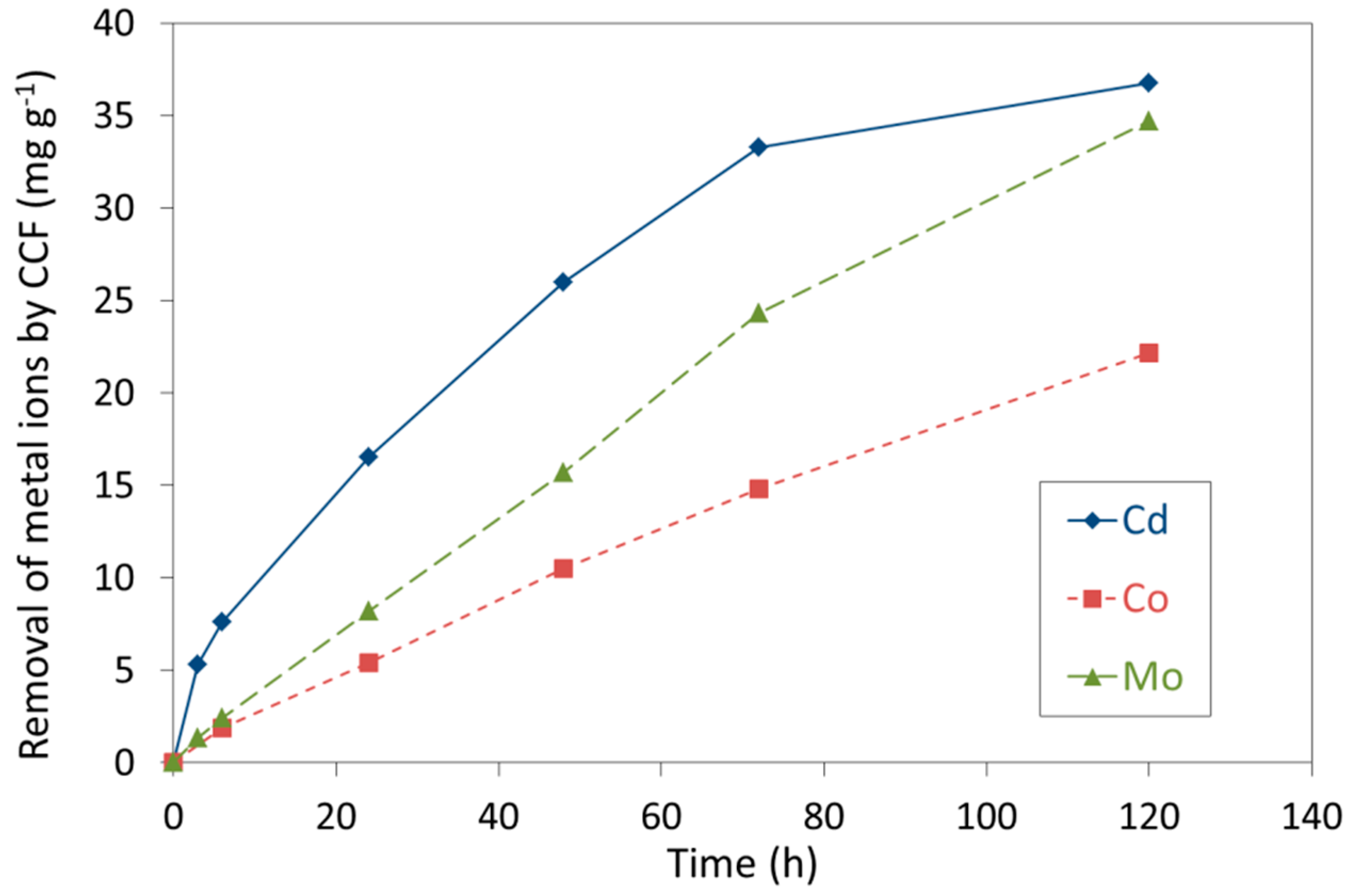
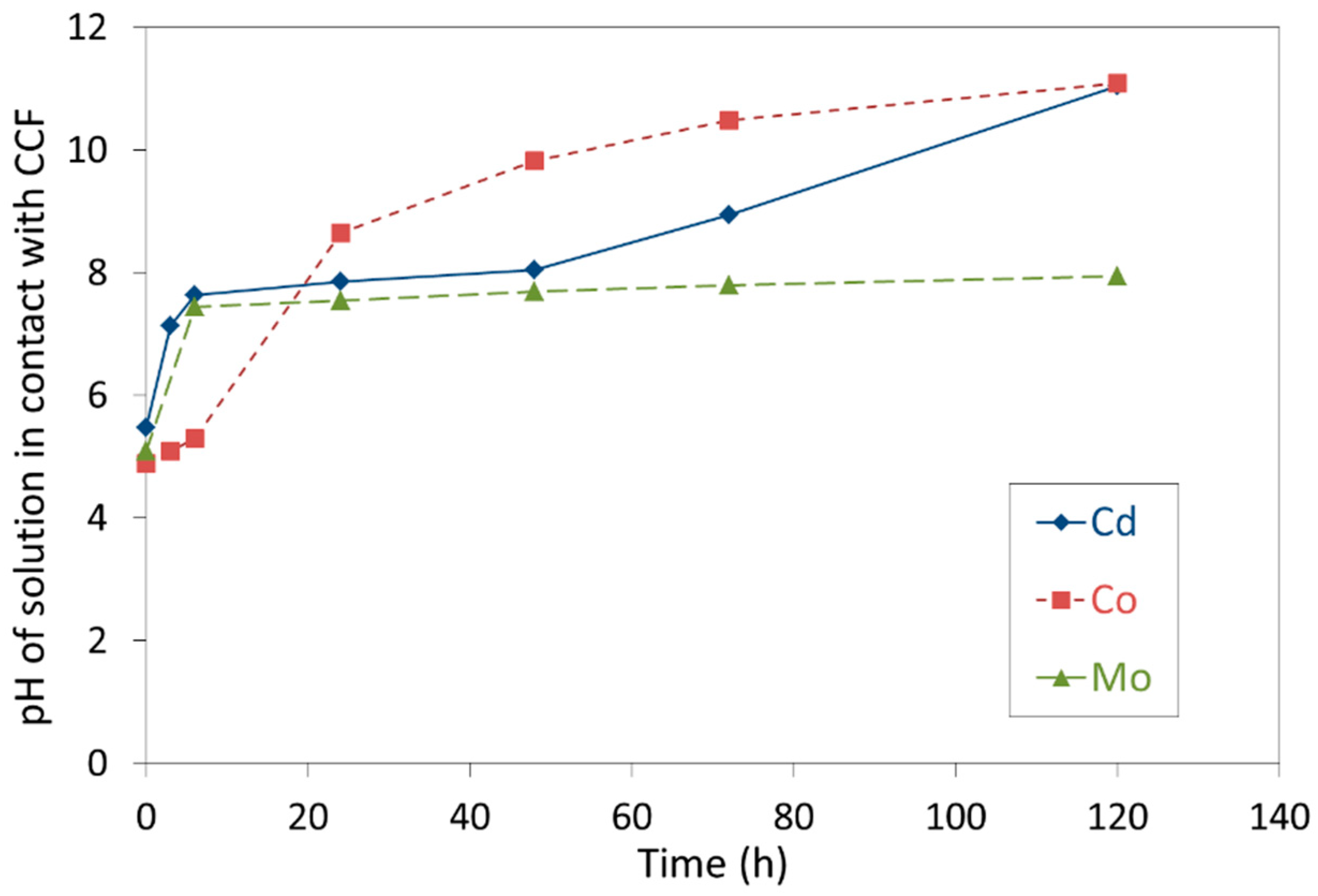

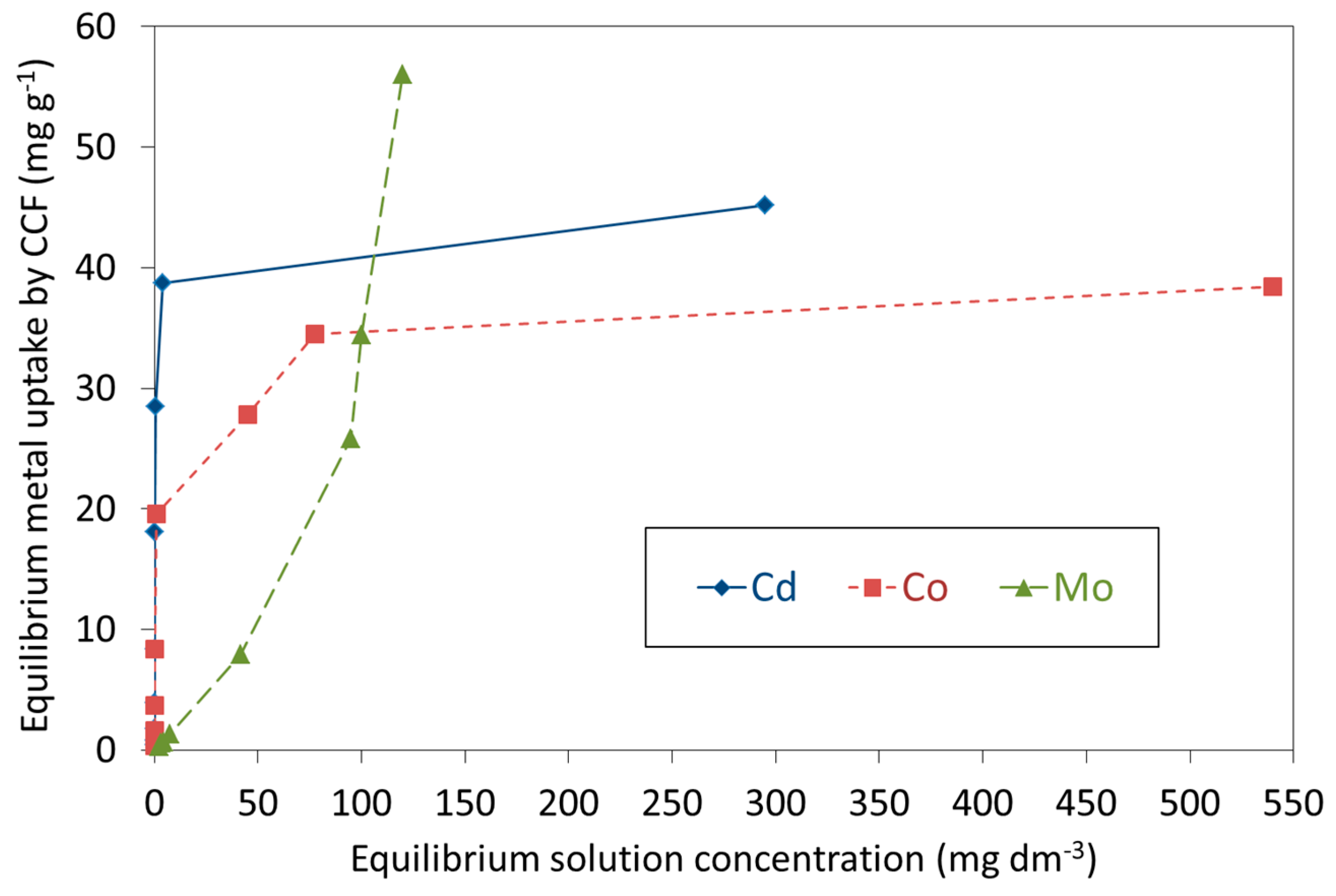
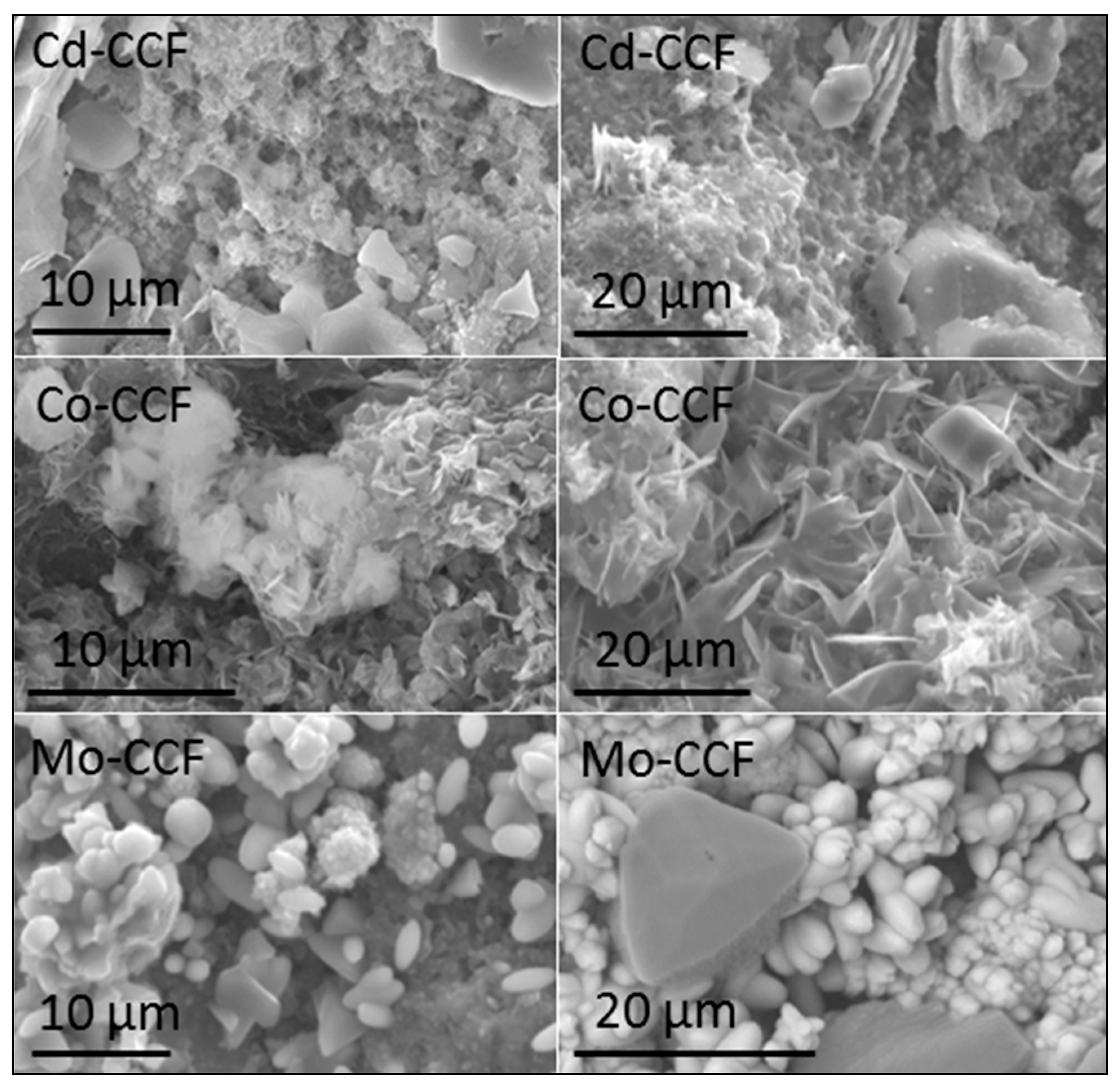
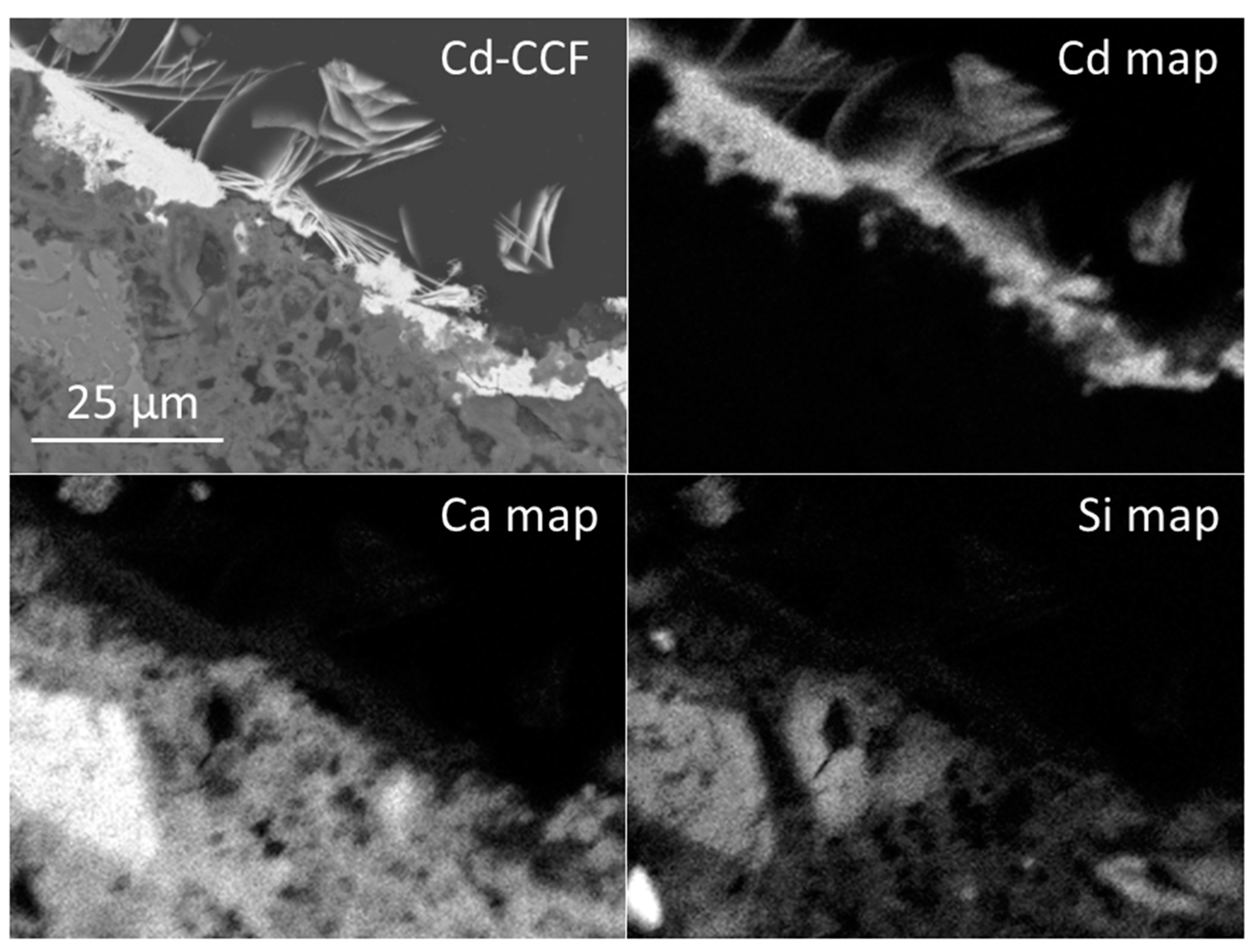


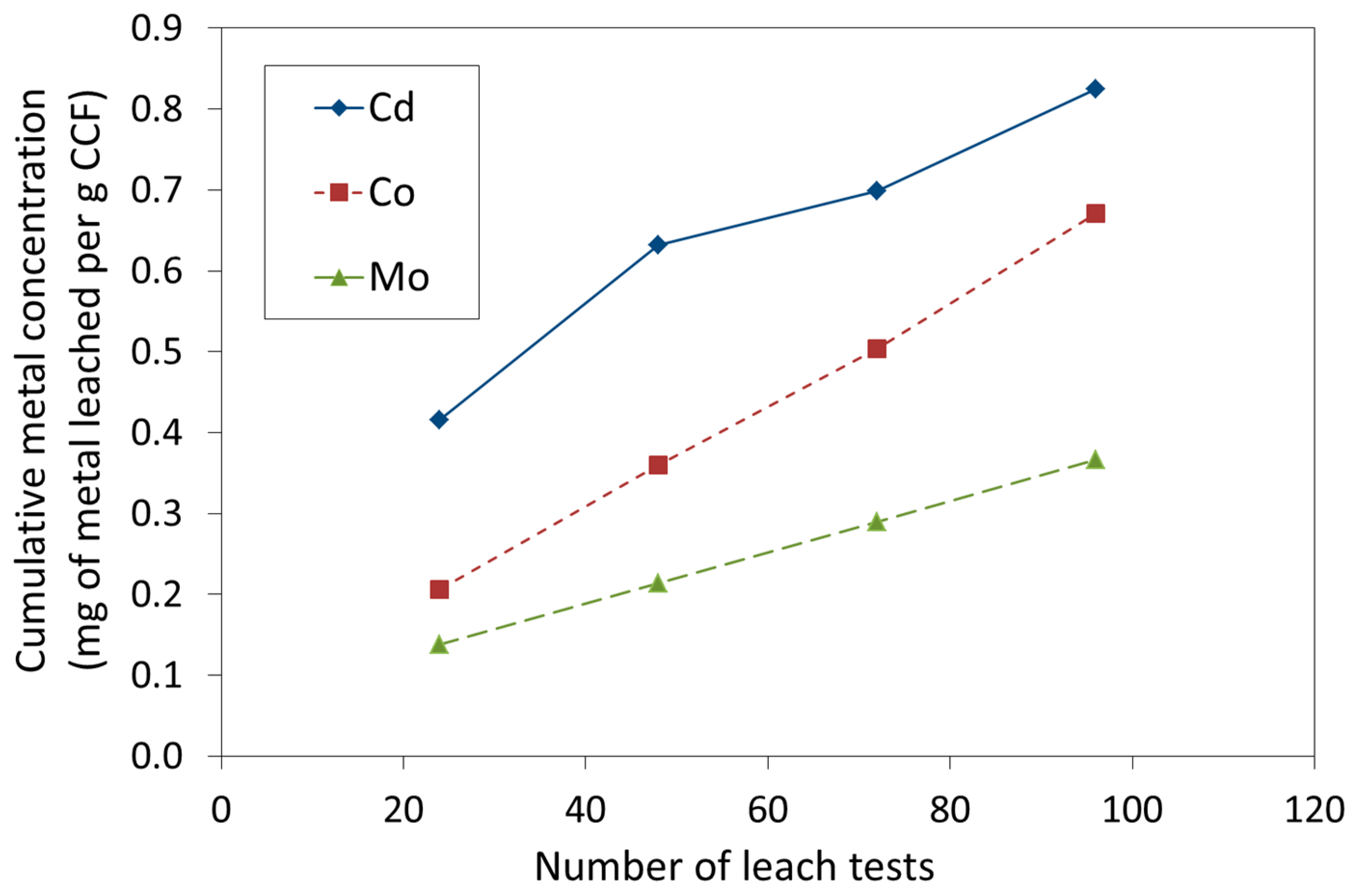
| Kinetic Parameter | Cd | Co | Mo |
|---|---|---|---|
| Zero order model | - | ||
| k0 (mg g−1 min−1) | 5.1 × 10−3 | 3.1 × 10−3 | 4.9 × 10−3 |
| R2 | 0.887 | 0.993 | 0.992 |
| Pseudo-first-order model | - | ||
| k1 (min−1) | 1.0×10−3 | 1.9 × 10−4 | 3.3 × 10−4 |
| qe calc. (mg g−1) | 63.6 | 30.6 | 43.5 |
| R2 | 0.881 | 0.985 | 0.945 |
| Pseudo-second-order model | - | ||
| k2 (g mg−1 min−1) | 2.3 × 10−5 | 1.2 × 10−6 | 5.1 × 10−7 |
| qe calc. (mg g−1) | 38.3 | 61.0 | 114.9 |
| R2 | 0.998 | 0.809 | 0.815 |
| Property 1 | Control | Cd | Co | Mo |
|---|---|---|---|---|
| Metal ion removal (mg g−1) | - | 38.7 | 34.5 | 34.7 |
| Calcium dissolution (mg g−1) | 7.42 | 18.51 | 17.26 | 7.25 |
| Sodium dissolution (mg g−1) | 0.25 | 0.27 | 0.32 | 0.27 |
| Potassium dissolution (mg g−1) | 0.50 | 0.58 | 0.69 | 0.53 |
| Aluminium dissolution (mg g−1) | 0.13 | 0.06 | 0.01 | 0.14 |
| Silicon dissolution (mg g−1) | 0.18 | 0.08 | 0.04 | 0.15 |
| pH | 11.6 | 11.4 | 11.6 | 11.3 |
| Isotherm Parameter | Cd | Co | Mo |
|---|---|---|---|
| Langmuir model | |||
| qm (mg g−1) | 45.2 | 38.5 | 24.6 |
| b (dm3 mg−1) | 1.34 | 0.29 | 0.006 |
| R2 | 0.999 | 0.999 | 0.824 |
| Freundlich model | |||
| KF (mg(1−1/n) dm3/n g−1) | 21.6 | 11.1 | 0.10 |
| 1/n | 0.169 | 0.235 | 1.255 |
| R2 | 0.639 | 0.784 | 0.991 |
| Structure | Relative Elemental Composition (Moles per Mole of Al) 1 | |||
|---|---|---|---|---|
| Al | Si | Ca | Metal ion | |
| Cd-CCF | ||||
| Cancellated network | 1.00 ± 0.29 | 2.52 ± 0.12 | 6.45 ± 0.24 | 5.38 ± 1.12 |
| Platy foils | 1.00 ± 0.41 | 4.28 ± 1.20 | 99.9 ± 5.2 | 9.59 ± 2.85 |
| Co-CCF | ||||
| Foliaceous network | 1.00 ± 0.12 | 0.93 ± 0.15 | 146.0 ± 0.8 | 7.17 ± 1.35 |
| Fluffy pom-poms | 1.00 ± 0.08 | 2.72 ± 0.29 | 1.32 ± 0.12 | 56.65 ± 0.91 |
| Mo-CCF | ||||
| Peloids | 1.00 ± 1.07 | 2.91 ± 2.32 | 34.03 ± 7.13 | 36.07 ± 3.41 |
| Distorted polygons | 1.00 ± 0.13 | 4.60 ± 0.24 | 131.1 ± 9.5 | 34.81 ± 6.7 |
| Sorbent | 1Ci Range (ppm) | Solid:Liquid Ratio (mg cm−3) | 2qm (mg g−1) | 3teq (min) | Ref. |
|---|---|---|---|---|---|
| Cadmium, Cd2+ | |||||
| Laboratory CCF | 10–1500 | 25 | 45.2 | 7200 | This study |
| Laboratory CCF | 0.4–4.0 | 25 | 0.294 | 1440 | [14] |
| Laboratory autoclaved CCF | 0–5000 | 100 | 15 | 1440 | [15] |
| NaOH-pretreated CCF | 5–200 | 1 | 0.61 | 1440 | [13] |
| Waste-derived tobermorite | 5.6–124 | 0.25 | 179 | 8640 | [32] |
| Waste dolomite | 500–2000 | 20–80 | 89.9 | 45 | [41] |
| Blast furnace slag | 0–5 | 0.1–20 | 5.1 | 1440 | [42] |
| Coal fly ash | 0–5 | 0.1–20 | 3.8 | 1440 | [42] |
| Cobalt, Co2+ | |||||
| Laboratory CCF | 10–1500 | 25 | 38.4 | 7200 | This study |
| Demolition CCF | 5.9–471 | 5 | 18.9 | 1440 | [5,6] |
| Waste-derived tobermorite | 0–100 | 50 | 10.47 | 7200 | [40] |
| Waste-derived calcium silicate | 200 | 2.5 | 78 | >300 | [43] |
| Red mud | 5.9–354 | 5 | 30.6 | 1440 | [44] |
| Molybdenum, MoO42− | |||||
| Laboratory CCF | 10–1500 | 25 | 56.0 | 10,080 | This study |
| Waste Fe/Mn hydroxides | 48 | 10 | 4.4 | 1440 | [45] |
| Synthetic goethite | 0–19 | 0.3 | 15.5 | 1020 | [46] |
| Zeolite-supported Fe3O4 | 0.1–5 | 0.025–0.5 | 17.92 | 1440 | [47] |
| Modified montmorillonite | 4798 | 20 | 37.2 | 1440 | [48] |
Publisher’s Note: MDPI stays neutral with regard to jurisdictional claims in published maps and institutional affiliations. |
© 2021 by the authors. Licensee MDPI, Basel, Switzerland. This article is an open access article distributed under the terms and conditions of the Creative Commons Attribution (CC BY) license (http://creativecommons.org/licenses/by/4.0/).
Share and Cite
Elmes, V.K.; Coleman, N.J. Interactions of Cd2+, Co2+ and MoO42− Ions with Crushed Concrete Fines. J. Compos. Sci. 2021, 5, 42. https://doi.org/10.3390/jcs5020042
Elmes VK, Coleman NJ. Interactions of Cd2+, Co2+ and MoO42− Ions with Crushed Concrete Fines. Journal of Composites Science. 2021; 5(2):42. https://doi.org/10.3390/jcs5020042
Chicago/Turabian StyleElmes, Victoria K., and Nichola J. Coleman. 2021. "Interactions of Cd2+, Co2+ and MoO42− Ions with Crushed Concrete Fines" Journal of Composites Science 5, no. 2: 42. https://doi.org/10.3390/jcs5020042
APA StyleElmes, V. K., & Coleman, N. J. (2021). Interactions of Cd2+, Co2+ and MoO42− Ions with Crushed Concrete Fines. Journal of Composites Science, 5(2), 42. https://doi.org/10.3390/jcs5020042





